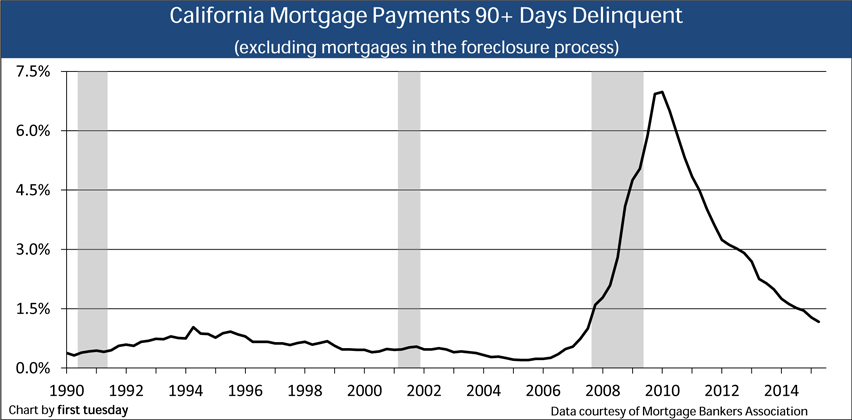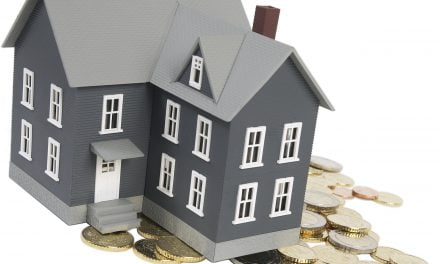The percentage of California mortgage debt 90+ days delinquent but not yet in foreclosure declined again to 1.2% in the second quarter (Q2) of 2015, down from 1.3% in the first quarter (Q1). This is down from 1.6% one year earlier. While the delinquency rate continues to slowly decrease, the normal percentage is around 0.5% at full recovery.
Movement in the 90-day mortgage delinquency rate sets the trend in short sales, notice of default (NOD) recordings, trustee’s sales (foreclosures) and real estate owned (REO) resales. Today, the peak in serious delinquencies has passed. However, at some point in late 2016 to early 2017, expect prices to decrease in response to rising interest rates. In turn, home equities will be diminished. This will cause delinquency rates to increase for around one year before falling back toward normal levels. A full recovery of the real estate market will occur around 2018-2019.
Updated August 18, 2015. Original copy posted June 2012.
Chart update 08/18/15
| Q2 2015 | Q1 2015 | Q2 2014 | |
| Rate of Delinquency | 1.2% | 1.3% | 1.6% |
Gray bars indicate periods of recession.
The above charts depict the percentage of California mortgage loans 90 or more days delinquent and not yet in foreclosure. Traditionally, lenders commenced foreclosure when a mortgage was 90 days delinquent.
Beginning January 2014, mortgage servicers are required to wait until a mortgage is at least 120 days delinquent before commencing foreclosure on a first lien mortgage secured by an owner’s principal residence. [12 Code of Federal Regulations §1024.41(f)(1)]
Loans delinquent and unlikely to be paid in full
In Q2 2015, 1.2% of all California mortgage loans were 90 or more days delinquent and not yet in foreclosure. These mortgages are headed for a notice of default (NOD) and foreclosure if a pre-foreclosure workout is not quickly arranged. This is down from the 7% peak delinquency level in Q1 2010, but still far above the quarterly average of 0.4% during 2000-2006.
Editor’s note —The chart above only includes loans which are 90 days or more delinquent, and are NOT in foreclosure. The 90+ day delinquency rate including loans in foreclosure is even higher (2.1% in Q2 2015). Thus, the chart above portrays a slightly more optimistic picture for lending than it would otherwise.
In about half of all instances, mortgage delinquency leads directly to foreclosure. Of course, once the foreclosure is complete, the property returns to the real estate market as a flipped property via speculator interference or as a real estate owned (REO) property.
The above chart depicts the most serious delinquencies — those most likely to lead to foreclosure — as a percentage of California mortgage loans. As the chart indicates, delinquencies jumped exponentially from an artificially low level during the Millennium Boom to new 70-year heights following the 2008 recession.
Today, the peak in serious delinquencies has passed, and a slow decline in the rate of delinquency is underway, aided by an improving job market.
Related article:
Delinquencies and foreclosures
Delinquencies gauge homeowners’ financial ability or willingness to continue paying their mortgage loans. Trends in the delinquency rate anticipate future levels of:
- NODs: the lender’s first step in the foreclosure process;
- trustee’s sales: the homeowner’s point of no return, when the lender or a third-party bidder acquires ownership of the home through foreclosure, leaving no further ability for the prior owner to reinstate the mortgage or redeem the property; and
- REO and related resales: the resale of property acquired by the lender at the trustee’s sale.
NOD recordings peaked in Q1 2009, with 135,431 NODs in that quarter alone. This was also the peak moment for REOs as a percentage of all home sales (excluding trustee’s sales). REO properties then comprised 54% of all homes sold statewide. For comparison, the average from 2000-2006 was 1.7%. Historically, REO resales have made up around 7% of the properties for sale.
Since 2009, NODs, trustee’s sales, and REO resales have all declined significantly, albeit fitfully, in a staircase movement.
Related article:
In contrast, the 90+ day delinquency rate peak came comparatively late, in the first quarter of 2010, and has since seen a gradual but constant fall.
This difference between delinquency (indicating the homeowner’s ability or willingness to pay a loan) and foreclosure (indicating the lender’s willingness to penalize the homeowner for their financial condition rather than provide a workout) shows that lenders’ decision to foreclose depends on other factors than simple delinquency.
As with foreclosures and REOs, the trend in delinquencies going forward is likely to continue downward. But it will also be slow, halting, and subject to occasional reversals (interest rates rising in late 2015 for example) as the housing market sputters back to ignition and take off.
Historical standards
In 1990-2000, the average 90+ day delinquency rate for California was 0.6%. By the end of the 1990s, home sales volume and prices were both rising, and the market had fully recovered from the 1990-91 recession. The Federal Reserve (the Fed) had already put the brakes on the economy by raising interest rates beginning in mid-1998, driving the economy into a mild and Fed-controllable recession in 2001.
When delinquency rates fall back to turn of the century levels, our economy — and the real estate market — will have attained full recovery. We currently anticipate this state of recovery to arrive around 2018-2019. This forecast is based on:
- the pace of job recovery;
- rising interest rates; and
- pervasive though improving negative equity conditions.
Factors at work in 2015
Several factors are at work to reduce delinquencies, particularly rising levels of employment and consumer confidence.
Job growth in California has exceed the 2007 peak of 15.6 million jobs. However, during the jobs recovery, California’s working-aged population increased by 1.2 million. As time passes and jobs develop, new employment will lead to increased demand for housing.
In the meantime, those homeowners with negative equity have diminished. 571,000 California homeowners owe more on their mortgage than their home is currently worth as of the first quarter (Q1) of 2015. Thus, most of them remain insolvent, candidates for bankruptcy (which would in most cases cause them to have to sell their home as a short sale or walk away).
Many of these homeowners will eventually become frustrated at the lack of upward home price movement in the years to come. They will then likely cease to pour their income into an insolvent homeownership situation. Instead, many will exercise their put option right to walk away from their home, mortgage and all, leaving the recalcitrant lender to deal with the property.
Related article:
Forecast for mortgage delinquencies
For a real estate recovery to take place, demand must be fueled by end users (not speculator activity). The single most important factor in generating end user demand for homeownership is the wealth of the population, as determined by jobs.
first tuesday does not anticipate significant sales volume attributable to end users until after 2016. For recent years, home sales volume has maintained a bumpy plateau: rising and falling from period to period.
However, as a result of asset and home price increases, the bond market, then the Fed, will raise interest rates to combat unsustainable growth, likely by early 2016. Mortgage rates will rise in anticipation, likely toward the end of 2015. This time, the Fed will have the additional task of withdrawing a huge portion of the dollars they infused into the banking system in an effort to drive the recovery.
Increased interest rates for the next decade or two will likely restrict price gains to the rate of inflation (historically maintained at 2-3%). Thus, delinquencies and REOs will likely remain constant even into 2018 and beyond.
This recovery is going to test the patience of all involved in the real estate market. In the end, speculators now stepping into the shoes of sellers will learn about the risk of loss that exists in the economy’s exit from the liquidity trap created by zero-bounded interest rates. This was last experienced in the U.S. during the 1950s as part of the recovery from the Great Depression and zero-bounded interest rates.















Lots of good info is this article. But one key omission. Short sales only became a viable alternative in CA after 2010, when they became subject to anti-deficiency protection. Prior to that many borrowers were talked into short sales only to learn later that they were still liable for part of the debt.
Some of the comments over-generalize. The credit effects of short sale vs. trustee sale vary widely depending upon the facts of each situation. E.g. a short sale with a long history of late payments may do more damage than a foreclosure that occurs soon after default. On the other hand a short sale normally allows eligibility for a new mortgage sooner than a foreclosure. [For a “clean” short sale, with no lates, FHA allows eligibility the day after close of the short sale. However, short sales are typically reported as “paid less than agreed”, NOT as satisfactory accounts.
Every $1.00 of short sale cost the banker 20cents and tax payers aka USA 80 cents!
Short sales are an alternative to foreclosure. However, your credit score is impacted largely by the number of derogatory lates in that mortgage your selling short. In cases, credit scores margings are close between the short sale and foreclosure. Although, short sale is the way to go to purchase again within a couple of years. Foreclosures require a 3 yr minimum with explanation. Also, data I recieved from a lender that i will keep nameless, a short sale is reported in a non-favorable way to the credit bureaus.
I beg to differ with the author “First Tuesday” regarding the comment that “For the homeowner, however, a shortsale is often as deleterious to the homowner’s credit score as an actual foreclosure, and does not represent an improvement in the financial well being of a delinquent homeowner.
To begin with, a short sale is much better than a foreclosure because on the credit report it shows the loan was paid satisfactorily. The homeowner, with established new credit, can buy again in 2 years or less. Plus a homeowner doing a short sale shows they took responsibility for the problem, found a solution good for everyone and closed the sale.
Plus their credit score will drop less and recover sooner for a short sale than for a foreclosure.
http://www.uscourts.gov/News/NewsView/12-05-09/Bankruptcy_Filings_Down_13_Percent_for_March.aspx?CntPageID=1